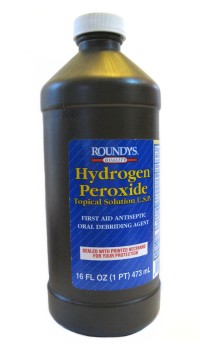|
You can make your kitchen a cleaner, safer place and fight bacteria, without
exposing yourself and your family to toxic chemicals that also damage the environment. You can use
a simple safe disinfecting spray that is more effective than any of the commercial cleaners in killing
bacteria. As a bonus, it is inexpensive!
Susan Sumner, a food scientist at Virginia Polytechnic Institute and State
University, worked out the recipe for just such a sanitizing combo. All you need is three percent
hydrogen peroxide, the same strength available at the drug store for gargling or disinfecting wounds,
and plain white or apple cidar vinegar, and a pair of brand new clean sprayers, like the kind you use
to dampen laundry before ironing. If you're cleaning vegetables or fruit, just spritz them well first
with both the vinegar and the hydrogen peroxide, and then rinse them off under running water.
It doesn't matter which you use first - you can spray with the vinegar then the
hydrogen peroxide, or with the hydrogen peroxide followed by the vinegar. You won't get any lingering
taste of vinegar or hydrogen peroxide, and neither is toxic to you if a small amount remains on the
produce. As a bonus: The paired sprays work exceptionally well in sanitizing counters and other food
preparation surfaces -- including wood cutting boards. In tests run at Virginia Polytechnic Institute
and State University, pairing the two mists killed virtually all Salmonella, Shigella, or E. coli
bacteria on heavily contaminated food and surfaces when used in this fashion, making this spray
combination more effective at killing these potentially lethal bacteria than chlorine bleach or
any commercially available kitchen cleaner.
|

|
The best results came from using one mist right after the other - it is 10 times
more effective than using either spray by itself and more effective than mixing the vinegar and
hydrogen peroxide in one sprayer.
Reference note:
Articles on Dr. Sumner's original research work appeared in the scientific news journal, "Science News,"
in the issues that were published on August 29, 1996, and on August 8, 1998.
Author's note, updated February 2008:
The question I get asked most by readers is, "Can I mix the hydrogen peroxide and vinegar into one
sprayer?" The short answer is: EEK - No! The longer answer is:
never mix hydrogen peroxide and vinegar together in one container. The resulting chemical,
peracetic acid, can harm you when mixed together this way if you accidentally create a strong
concentration in this fashion. Peracetic acid also has entirely different characteristics and
properties than either hydrogen peroxide or vinegar. Additionally, we don't know if peracetic acid
kills the same group of pathogenic food-borne bacteria when used this way as a spray - it very well
may not.
|
|
MiniFAQ: The questions we get asked the most about this article, with
answers.
- Can I use apple cider vinegar (or rice vinegar or some other type of vinegar than white
distilled vinegar)?
Answer: As far as I know using apple cider vinegar or any other vinegar works the same as
the white distilled vinegar -- no better and no worse.
- Do I have to dilute the vinegar?
Answer: In the United States, the vinegar you buy at a grocery store for use in
cooking or in salad dressings is already diluted and ready to use in the way this article
describes. The bottle will say on the label somewhere "5% acidity." In other countries, check
the vinegar bottle's label and make sure that the vinegar you are buying is already diluted so
that it is only 5% acidity.
- Isn't spraying hydrogen peroxide and then spraying vinegar right after each other the same
as mixing them together and then spraying that solution?
Answer: Absolutely not. Chemical reactions that occur in closed containers can be quite
different than reactions that occur in open air. Hydrogen peroxide and any type of vinegar
should especially never be combined in a closed container, like a spray bottle. You don't
want to pour the two together in an open container either, but you absolutely never ever mix
them in a closed container. Spraying them one after the other does not cause the same kind
of chemical reaction that putting them together in a closed container can, or that (under
the right conditions) might occur when pouring them together in an open container.
- This disinfection technique works because it's creating peracetic acid when you spray one
after the other, right?
Answer: No, not when you spray one, then the other, according to conversations I've had with
the original researcher and other experts since then.
- Why do you make such a big deal about avoiding peracetic acid?
Answer: Peracetic acid can be highly corrosive, and it is a "primary" irritant. It can
permanently damage the lungs, and cause occupational asthma. It can also have other chemical
properties depending on the concentration that make it quite dangerous in other ways as well.
|

